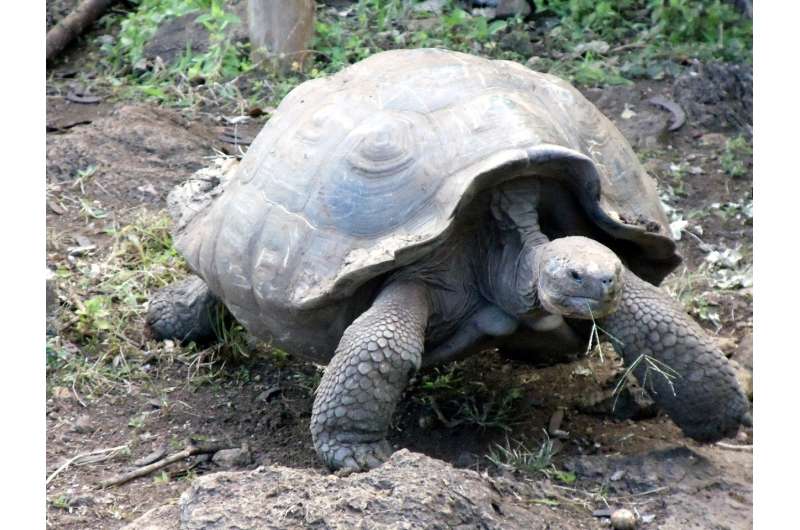December 1, 2017 report
Comparing the amount of energy needed by two species of Galapagos tortoises to flip back over once overturned

(Phys.org)—A team of researchers with members from the U.S., Portugal and France has conducted a study of the amount of energy required by the two main types of tortoises that reside on the Galapagos Islands—the domed and the saddleback—to flip themselves right side up when they overturn. In their paper published in Scientific Reports, the group describes analyzing shells of the two tortoise types, comparing them and then calculating which required more energy to flip itself back upright.
The giant tortoises that live on the Galapagos Islands are world famous due to their huge size. Less well known is that there are two main types defined by differently shaped shells: domed and saddleback. The domed species are the ones mostly seen in tourist pictures. Less popular are the saddleback, which have a shoehorn-shaped part of their shell near the neck, flatter shells and longer necks. Both kinds tend to tip over due to rough terrain or when fighting with one another. But which has to expend more energy to right itself? That is what the team on this new effort sought to find out.
To figure out how much energy each type would have to expend in tipping itself back upright, the researchers studied the techniques used by both: The domed species tend to move their legs around until they work up enough momentum to turn over. The saddlebacks, on the other hand, used their necks in addition to flailing their legs. The group then took pictures of 89 of the shells (many from inside museums) to create 3-D versions on a computer. Then, at the Rotterdam Zoo, the team hoisted one of the turtles onto a platform connected to equipment that produced the desired result.
Putting all their data together, the researchers found that saddleback tortoises have to use more energy to right themselves than do those of the domed species. Noting that being unable to flip over is a leading cause of death of the tortoises, the group suggests the different shell types may have evolved to handle tipping under different environmental circumstances.
More information: Ylenia Chiari et al. Self-righting potential and the evolution of shell shape in Galápagos tortoises, Scientific Reports (2017). DOI: 10.1038/s41598-017-15787-7
Abstract
Self-righting, the capacity of an animal to self-turn after falling on its back, is a fitness-related trait. Delayed self-righting can result in loss of mating opportunities or death. Traits involved in self-righting may therefore be under selection. Galápagos giant tortoises have two main shell morphologies - saddleback and domed – that have been proposed to be adaptive. The more sloped shape on the sides of the shell and the longer extension of neck and legs of the saddlebacks could have evolved to optimize self-righting. The drier environments with more uneven surfaces where the saddleback tortoises occur increases their risk to fall on their back while walking. The ability to fast overturn could reduce the danger of dying. To test this hypothesis, we used 3D shell reconstructions of 89 Galápagos giant tortoises from three domed and two saddleback species to compare self-righting potential of the two shell morphotypes. Our results indicate that saddleback shells require higher energy input to self-right than domed ones. This suggests that several traits associated with the saddleback shell morphology could have evolved to facilitate self-righting. Studying the functional performances of fitness-related traits, as in this work, could provide important insight into the adaptive value of traits.
Journal information: Scientific Reports
© 2017 Phys.org



















